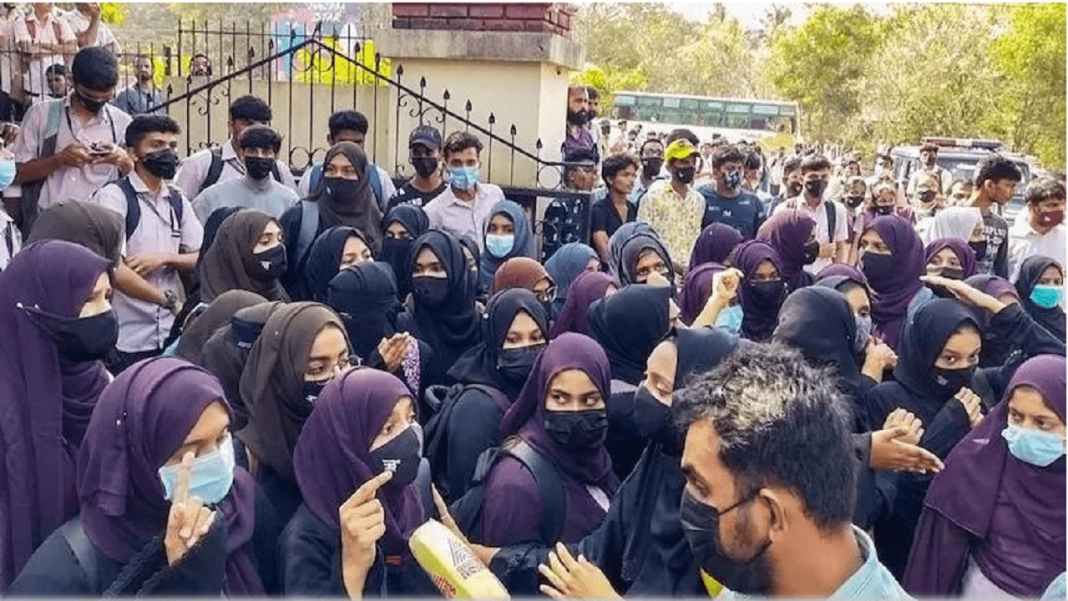By Farhat Naim
Unity in Diversity is the core tenet that holds India together. But despite the respect for this diversity, Muslim women, who choose to cover their heads with the hijab as a sign of modesty, have faced discrimination.
The wearing of the hijab as a choice by right has become a worldwide issue for Muslim women as it is seen as a sign of oppression. In Singapore, women are not allowed to wear headscarves in the workplace. Having to put this choice to work without scarf or not to work at all is unfair and unjust.
In 2017, three panchayat presidents from Kerala participating in the International Women’s Day were denied access to the event because they were wearing hijab.
In India, the recent order by the Government of Karnataka has forced several hijabi students to protest outside their educational institution. It states that the, “clothes that disturb equality, integrity and public law & order should not be worn” and prohibiting the entry of Muslim girls in hijab is a continuation of the discrimination made against a community.
Regardless of the protest which has taken a communal colour, the Karnataka High Court did not pass interim relief to allow women students to take classes with hijab. Following the above order, a petition was filed before the High Court of Karnataka. Senior Advocates Sanjay Hegde and Devadatt Kamat are representing the petitioners.
The said rule made by the Government cannot be imposed upon students who took admission two months before when, according to their rules, wearing hijab was allowed. The arbitrary change in rules has been made without notice and now students are asked to either adhere to the rule or stop coming to college, which is despotic and unconstitutional in nature.
If the right to wear hijab is claimed under Article 25 then doctrine of “essentiality” as laid down by the Apex Court in the case of Shirur Mutt in 1954 will be applied and the need to prove the practice of wearing hijab “integral” to Islam will be required. The right under Article 25 and 26 of the Constitution is not an absolute right. It is subject to “public order, morality and health”.
The larger interest of society for the purpose of maintaining public order is to be considered. In the given Karnataka instance, Muslim women are denied entrance in their college because they cover their head. The college wants to have a secular outlook but it invites question for various other religious practises too, like wearing laal dhaga, applying tika, etc. Under Article 14, the students who choose to wear scarves cannot be denied the same opportunity to attend classes than students who choose not to wear scarves.
In 2015, Kerala High Court in the case of Nadha Raheem v. Central Board of Secondary Education held “religious sentiments be not hurt and at the same time, discipline be not compromised.” In this case, the dress code prescribed for examination by the CBSE was of wearing half-sleeve kurta/salvar to ensure that no cheating my means of electronic gadgets wired or camouflaged to the body happens in the exam. But the court found an amicable way by directing candidates wearing hijab to reach the examination hall half-an-hour prior for the Invigilator to examine.
In the case of Masud Alam v. Commissioner of Police, it was stated that the State protects the religious faith and belief under Article 25, not religious practises. If the religious practise is against public order, morality or health, then the practise must give way for the good of society. In 1992, Justice Eusoff of Malaysian High Court delivered a judgment ruling that the freedom of religion guaranteed under Article 11(1) of the Malaysian Constitution was not absolute. It is subject to any general law relating to public order, public health or morality. The statement of Muslim scholars was noted that “purdah (face covering) is not essential but covering of head by scarf is obligatory.” The purpose of uniform is to protect the students from inferiority complex and peer pressure that could come about due to different financial backgrounds. It contains a public-facing message and a sense of identity but the aim is uniformity of values. But the State, at the same time, also has to protect the religious belief of the individuals.
In 2017, the United States Military Academy changed its policy to allow Sikh soldiers to keep unshorn hair, beards and wear turbans while in uniform. Lieutenant Colonel Kamaljeet Singh Kalsi, the first Sikh soldier to be allowed to stick to his religious practise by the US Pentagon, said uniformity is more than a mere outward expression.
Hijab being a part of essential religious practices needs deeper examination, according to the Karnataka High Court and until the final order is passed the Court has restrained the students, regardless of their religion or faith, from wearing saffron shawls, scarves, hijab, religious flags or the like within the classroom.
But the question is if the conscience of the person does not allow them to reveal more skin/hairs, how can the State by any law snatch their right to dress up modestly. It needs to be considered that wearing of a scarf does not affect the right of any other person but snatching it away is a blow to the modesty of a person.
Farhat Naim is a third-year law student from DME, Guru Gobind Singh University.


